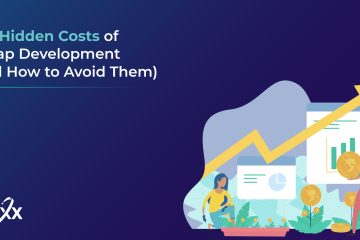One may ask, what’s wrong with a powerful brainstorming session to develop concrete user experience (UX)design solution in one go? While that may seem like hitting the bull’s eye, it is futile. There is a popular saying – “Look before you leap.” The same goes for UX design. Prototyping is an integral step in creating a successful UX design.
Building a prototype can immensely help you in thoroughly checking the usability and reliability of your design before you decide to take the giant leap towards launching your project. Not only does prototyping help experimenting with new ideas but also saves a lot of time, money, and effort! In other words, prototyping and developing should always go hand in hand for arriving at an exemplary design.
How beneficial is prototyping?
Let’s say, you want to show your team how a navigation slider will work for an end-user. Rather than presenting a bunch of ambiguous static screenshots, a well-crafted prototype will be just like a picture worth a thousand words. Such a prototype will not only allow your team members to understand and communicate your ideas effectively but also help with aligning people and getting relevant feedback from the team in a streamlined manner.
Saves time and energy
Most of the design teams adopt a combination of both Waterfall and Agile methodologies, however, before getting into the agile framework, it is essential for the design strategy to follow the waterfall methodology. This combination results in a better end-product.
However, to be on the same page and to stay away from unnecessary comprehensive documentation requirements, prototyping has always favoured the waterfall development lifecycle.
Since the frequency of validating the interactions and user-flows is much less with the integration of prototypes in the workflow, designers can save a lot of time and energy with prototyping. Not to mention that the quality of the discussions and feedback around the designs is much better.
Enhances customer satisfaction
Without a single line of code, your first prototype will allow users to interact with the design seamlessly. One does not even need to have access to a full-time researcher. User research can be done easily in an affordable manner with a prototype. The feedback gained from users about the performance of the UX design can prove to be valuable inputs to build a better design.
After all, who would want to offer a poor user experience to end-users? That is why a workable prototype with a simple usability testing model will save hours of frustration and allow designers to figure out and fix things much earlier in the product development lifecycle.
Increases reliability and rapidity
With the growing trend of rapid prototyping, designers would also reap its benefits for developing a prototype efficiently. Simply put, rapid prototyping allows multiple designers to collaborate and often results in better chances of developing an extensive range of ideas if your first prototype was a failure. However, one should opt for low-fidelity prototyping if there will be many iterations of prototyping. Another advantage of rapid prototyping is that it allows early testing with real users which, in turn, will be beneficial for fast-tracking the pace of development.
Also, collecting user’s feedback is vital to keep mistakes at bay. When you develop an application or product from the start till the end, without keeping users in mind, you might end up developing a product offering a less than optimal user experience. It is better to have a “slow and steady” feedback-driven approach from the initial stages in order to decrease the number of prototyping iterations and will be quicker.
Boosts team togetherness and productivity
Prototyping forces team members to work closely, it reveals the strengths and weaknesses of the design team as a whole. It encourages the team to be creative and generate exciting ideas spontaneously. To develop a first-class product, having a team with a strong sense of team spirit and morale is essential and prototyping makes space for this. With the required focus and motivation, it can drive teams to deliver the best in the least possible time.
Today, prototyping has become a must for any product development lifecycle. However, designers need to choose the right fidelity as per the time needed for validation of basic concepts, information architecture, user journeys, or gaining concrete feedback.
Solving problems is never a smooth process. While prototyping is still a stage where designers soil their hands, it is safer to say that prototyping makes the product a better end-product. Additionally, prototyping helps in gaining constructive feedback from your users and team members. Also, having a crystal-clear picture of the design requirements is the primary key to the successful development of a product. That being said, if you are also looking for a team of reliable and creative professionals to collaborate with, get in touch with us right away! We can help you make your design process hassle-free and successful with our design-first approach leading your product development process.


